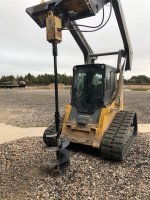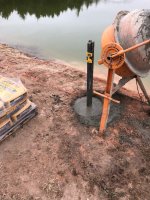Disclaimer......whatever advice contained within this post is worth exactly what you pay for it. And in the event of a failure, or error on my part, you are entitled to a full refund of what you pay me for this advise.
Now that thats out of the way.....I cannot say weather the 1x4 bar is gonna work or not. Because its not a simple problem. Soil, concrete, footing size, etc. The steel may rip right out of the concrete, or the concrete may rip out of the ground, or the steel may break/bend.....I dont know the loads involved.....and dont know what the MFG has designed their piers of I-beams to be able to withstand. And the ones you pictured.....dont even know what size beams those are.
But what we can do is make some comparisons.
With such short beams.....even the 4-foot I-beams.....deflection is really not a concern. Rather stress. If you are using A36 (36ksi steel), and you exceed stress levels of 36ksi.....that dont mean its going to break. It means its deflected far enough that it will no longer return to shape. (It bent:laughing

So, sparing everyone the long math and formulas....
A 1x4 piece of flat bar, in the strong 4" direction....That can handle ~8000# before exceeding 36,000psi
Same bar, in the weaker 1" direction.....That can handle ~2000# before exceeding 36,000psi
Assuming the pictures of the dock in your first post are 48" tall piers.....
The closest two beams in strength are a W6x16 being slightly weaker, and a W6x20 being slightly stronger.
A W6x16 sticking up 48" would handle 7650# in the X direction and 1650# in the Y
A W6x20 sticking up 48: would handle 10,000# in the X and 3300# in the Y direction.
W6x16 is a 6" x 4" I beam
W6x20 is a 6" x 6" I beam.
And based on the design of those stabilizers......if their intent is to triangulate so the dock cannot sway in the wind.....it looks like 99% of your force is going to be in the strong direction. Dont really see how its possible to get much side loading on that 1x4 bar unless you run into it with a tractor:laughing:
If you want to know how a different shape (beam, tube, etc) stack up in comparison, let me know. Punching the numbers in a calc are pretty easy. As long as they are a standard shape and I can source specs for said shape. Weldments or odd/modified shapes are a little more challenging.





